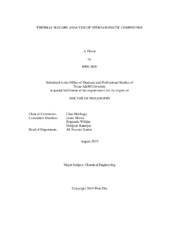| dc.description.abstract | Nitroaromatic compounds are among the largest group of industry chemicals. Due to the high bond-association energy (BDE) of the C-NO2 in nitroaromatic compounds (297 ± 17 kJ/mole), once the runaway reaction is triggered, the compounds will release massive heat and gases that accelerate the system temperature and pressure increase that lead to an explosion instantly. Mononitrotoluenes (MNT) is among most important nitroaromatic compounds used as intermediates for the synthetic pharmaceuticals, agrochemicals and precursors for TNT. However, in the past 30 years, serious incidents, owing to its thermal decomposition, have killed 88 people and injured more than 900. To help prevent future thermal runaway behavior of the nitroaromatic compounds, this work presents using both the experimental and simulation methodologies to figure out the thermochemistry and thermodynamics starting from MNT. The understanding of the thermal behaviors and mechanisms can yield safer handling and storage of the reactive chemicals. To investigate the mechanisms that cause the ortho-nitrotoluene (2-NT, isomer of MNT) decomposition reactions, the effects of different incompatible substances and surrounding conditions, such as confinement, heating rate, induction effect and sample sizes, were studied using three types of calorimetry – DSC, ARSST and APTAC. Experimental results suggest that: 2-NT is the most hazardous reactive chemical among the three isomers of MNT with the much higher pressure rise rate than the others. It is an autocatalytic reaction follows three stages: induction phase, acceleration phase and decay phase. The induction phase follows the zero order reaction with activation energy (170-174 kJ mol-1 ) and preexponential factor (1011.6 -1011.7 s -1 ).
The main decomposition pathway during reduction phase is the generation of anthranil and water. The six common contaminants (NaOH, Na2SO4, CaCl2, NaCl, Na2CO3 and Fe2O3) that exist in the manufacturing process of MNT lower the thermal stability of 2-NT with the three proposed mechanisms (generation of OH- , impact of chloride ions and Iron (III) oxide catalyzed nitroarenes reduction). This work demonstrates the complexity and the multiple studies required for making MNT safer, providing suggestions to the nitroaromatics industry. It can also serve as an example for comprehensive studies on various reactive chemicals. | en |


